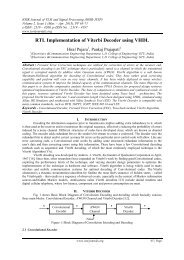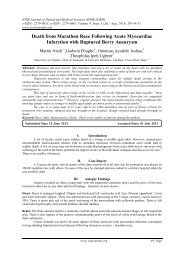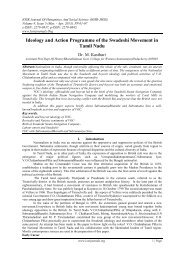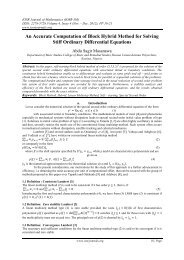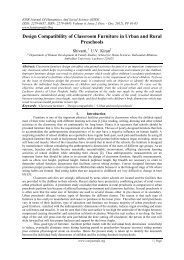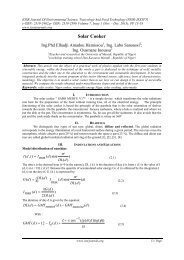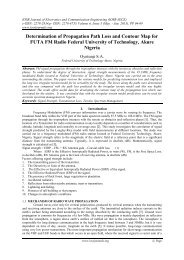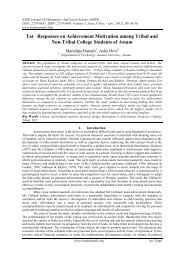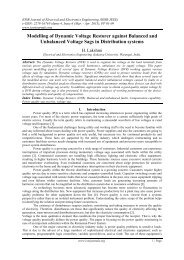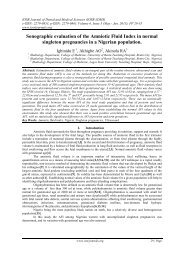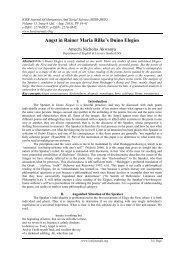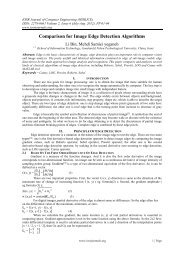Estrogen And Progesterone Receptors In Dysfunctional ... - IOSR
Estrogen And Progesterone Receptors In Dysfunctional ... - IOSR
Estrogen And Progesterone Receptors In Dysfunctional ... - IOSR
You also want an ePaper? Increase the reach of your titles
YUMPU automatically turns print PDFs into web optimized ePapers that Google loves.
<strong>Estrogen</strong> <strong>And</strong> <strong>Progesterone</strong> <strong>Receptors</strong> <strong>In</strong> <strong>Dysfunctional</strong> Uterine Bleeding<br />
Immunoflorescence technique. The histopathology report was then correlated with the estradiol levels.<br />
Estimation of ER & PR receptors were done using leica reagents. Morphometric analysis of glands and stroma<br />
were done with appropriate controls. The results of histopathology, LMP, Estradiol levels, special stains and<br />
ER, PR receptors were correlated and analyzed to conclude the cause of menorrhagia. The analyzed data was<br />
compared with other series in literature and discussed.<br />
The data is tabulated and analysed using Chi-Square test. P value of 20=5+) was increased in disordered proliferation,<br />
simple endometrial hyperplasia and very high in complex endometrial hyperplasia and endometrial carcinoma.<br />
Gland: stroma ratio was very high in simple endometrial hyperplasia, complex endometrial hyperplasia and<br />
endometrial carcinoma.<br />
The most common glands seen were cylindrical. Simple endometrial hyperplasia, complex endometrial<br />
hyperplasia and endometrial carcinoma had ramified glands.<br />
Simple endometrial hyperplasia, complex endometrial hyperplasia and endometrial carcinoma had increased<br />
lumen/gland relative volume and showed increased number capillaries/mm 2 stroma.<br />
IV. Discussion<br />
Menstrual disorders are common, accounting for almost 3% of all outpatient referrals and over 20% of<br />
referrals to gynecology outpatients’ clinics. 1 <strong>In</strong> this study the maximum age incidence of patients suffering from<br />
menorrhagia was between 31-40 years. Pilli GS et al 2 , Madiha Sajjad 3 et al and Archana 4 et al reported that the<br />
common age incidence was between 40-50 years, while Sadia Khan 5 et al reported as 45-55, Shazia Riaz et al 6<br />
as 45-50 and Layla et al 7 more then 52.<br />
Studies done<br />
Age incidence<br />
Sadia Khan 5 (2011) 45-55<br />
Layla 7 (2011) >52<br />
Madiha Sajjad 3 (2011) 40-50<br />
Shazia Riaz 6 (2010) 45-49<br />
Archana 4 (2010) 40-50<br />
Present study 31-40<br />
<strong>In</strong> this study the most common pattern seen was proliferative phase (40%). Pilli GS et al 2 reported endometrial<br />
hyperplasia as most common (44%), while Sadia Khan et al 5 reported proliferative phase (46%), Shazia Riaz 6<br />
(33%), Archana et al 4 (53%). Layla et al 7 reported secretory phase in 24% of cases.<br />
Studies done Endometrial patterns Percentage<br />
Sadia Khan 5 (2011) Proliferative phase 46<br />
Layla 7 (2011) Secretory phase 24<br />
Shazia Riaz 6 (2010) Proliferative phase 33<br />
Archana 4 (2010) Proliferative phase 53<br />
Present study Proliferative endometrium 40<br />
www.iosrjournals.org<br />
74 | Page



